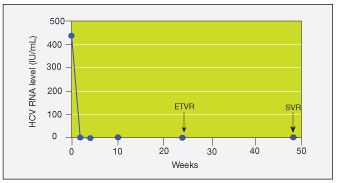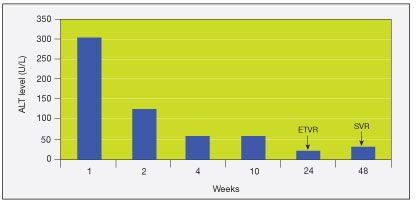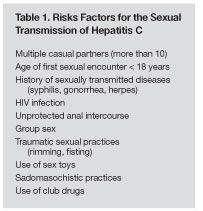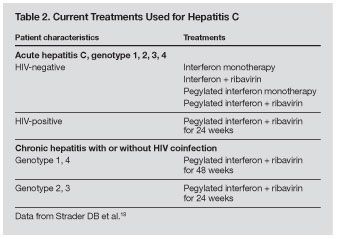Treatment of Acute Hepatitis C in an HIV-Positive Man With Pegylated Interferon and Ribavirin for 24 Weeks
An epidemic of acute hepatitis C is emerging among HIV-infected men who have sex with men (MSM), with a growing number of cases reported in the MSM population in the United States and Europe.
According to the World Health Organization, 10 million people worldwide are coinfected with the hepatitis C virus (HCV) and HIV.1 Both are RNA viruses contracted through similar routes of transmission. Coinfection accelerates liver disease progression. Currently, the leading cause of death in the HIV/HCV-coinfected population is end-stage liver disease.2,3
The number of cases of acute hepatitis C reported in the HIV-infected men who have sex with men (MSM) is increasing in the United States and Europe. We report a case of a 47-year-old HIV-infected MSM who sexually contracted acute hepatitis C and was treated with pegylated interferon and ribavirin for 24 weeks.
CASE SUMMARY
Acute HIV infection was diagnosed in a 47-year-old white MSM after initial presentation with fever, rash, and myalgia. He reported unprotected oral and anal-receptive intercourse as his only risk factor for HIV infection. The patient's medical history was significant for additional sexually transmitted infections: Chlamydia infection and herpes simplex. The patient denied intravenous drug use but acknowledged that he drinks 1 to 2 glasses of wine daily and smokes crystal methamphetamine on weekends. Serological tests for hepatitis before HIV treatment was started indicated reactive hepatitis A and B virus antibodies; results were negative for HCV antibody.
The patient enrolled in a study of acute HIV syndrome within a large AIDS research center. At study entry, his HIV RNA level and CD4+ cell count were greater than 750,000 copies/mL and 450/µL, respectively, and he was randomized to receive antiretroviral therapy with efavirenz and the fixed-dose, triple-NRTI regimen of zidovudine/lamivudine/abacavir. At week 3, the patient's HIV RNA level was below 50 copies/mL and his CD4+ cell count was 690/µL.
Two years after his HIV diagnosis and initiation of therapy, routine laboratory tests revealed elevated liver enzyme levels, most notably an alanine aminotransferase (ALT) level 10 times above the upper limit of normal, despite an asymptomatic presentation. His antiretroviral treatment was discontinued, and a serological test for hepatitis was repeated. The test result was positive for HCV antibody with genotype 1b, even though he had no history of intravenous drug use and was initially HCV antibody–negative before starting antiretroviral therapy.
He reported a recent sexual encounter during which he engaged in unprotected sex after methamphetamine use. He denied symptoms suggestive of acute viral hepatitis (eg, anorexia, nausea, vomiting, malaise, or right upper quadrant discomfort).
The patient was referred to Mount Sinai Medical Center, New York, for evaluation and possible treatment for acute hepatitis C. His HCV RNA level was initially 1,700,000 IU/mL and ALT level was 389 U/L (normal, 3 to 60); his treatment for HIV infection was stopped. After 12 weeks of observation, his HCV RNA level dropped significantly without treatment. However, the patient had not spontaneously cleared the virus, and his ALT level remained elevated. New treatment was begun with pegylated interferon alfa 2a 180 µg/wk and ribavirin 800 mg/d.
Two weeks after starting treatment, the patient had a 2-log drop in his HCV RNA level and tolerated therapy without any significant adverse effects. His HCV RNA level became undetectable after 4 weeks of therapy (Figure 1), which is a good predictor of sustained virological response (SVR). His ALT level also normalized as shown in Figure 2. At the end of 24 weeks of treatment, he had achieved an end-of-treatment response and 6 months later, an SVR.
One year after the 24-week treatment course for acute hepatitis C, the patient continues to have an undetectable HCV RNA level, an HIV RNA level of 93,000 copies/mL, and a CD4+ cell count of 412/µL. His antiretroviral therapy has not been restarted.

Figure 1. Treatment of acute hepatitis C with pegylated interferon and ribavirin for 24 weeks: Change from baseline in hepatitis C virus (HCV) RNA level. (ETVR, end-of-treatment response; SVR, sustained virological response.)

Figure 2. Treatment of acute hepatitis C with pegylated interferon and ribavirin for 24 weeks: Change from baseline in alanine aminotransferase (ALT) level. (ETVR, end-of-treatment response; SVR, sustained virological response.)
DISCUSSION
Acute hepatitis C is defined as the initial 6-month period following infection but may also be defined as a documented seroconversion to anti-HCV positivity by enzyme-linked immunosorbent assay, a serum ALT level of at least 10 times the upper limit of normal (excluding other causes),4 or detectable plasma levels of HCV RNA using polymerase chain reaction assay.5 Patients who are severely immunocompromised with a CD4+ cell count of less than 100/µL are less likely to seroconvert to anti-HCV positivity.4
Acute hepatitis C accounts for 20% of acute hepatitis today, and it can progress to chronic hepatitis in 55% to 85% of patients.6 Patients with acute hepatitis C are usually asymptomatic with an elevation of ALT levels 6 to 12 weeks after exposure.7 However, symptoms of acute viral hepatitis, including anorexia, nausea, malaise, right upper quadrant discomfort, and jaundice, may develop in 25% of patients.8,9 Evidence has shown that patients with symptomatic acute hepatitis C are more likely to achieve spontaneous viral clearance.10,11 For patients who have persistent viremia after 12 weeks, treatment is recommended12 to prevent the development of chronic hepatitis C, therefore reducing the risk of cirrhosis, end-stage liver disease, and hepatocellular carcinoma.
There has been an increased incidence of sexually transmitted hepatitis C among HIV-infected MSM who engage in high-risk, unprotected sexual behavior.4 These sexual practices include unprotected insertive and receptive anal intercourse, rimming, fisting, and oral sex.13 Other reasons for the increased risk of sexual transmission of hepatitis C include having had multiple casual partners (ie, more than 10 lifetime sexual partners) (Table 1).13

Currently, there is also an increasing incidence of seroconcordant sexual partnering, ie, HIV-infected men seeking other HIV-positive partners to have unprotected sex; this behavior is seen as a "harm reduction strategy."4 Sexual partnering also takes place via the Internet, allowing privacy and a relatively effortless means of meeting others who engage in similar risky behavior. Furthermore, the use of "club drugs," such as ketamine, LSD, Ecstasy, methamphetamine, and γ-hydroxybutyrate (GHB), has also been reported in patients who have acquired sexually transmitted hepatitis C.4
The number of cases of sexually acquired acute hepatitis C in the HIV-infected MSM population continues to grow in Europe14-16 and the United States.17 Patients with HIV/ HCV coinfection have higher HCV RNA levels and a greater risk of liver disease progression than do patients with HCV monoinfection. When patients are monitored in the first 12 weeks for spontaneous clearance, the rate of HCV RNA clearance is significantly lower in coinfected patients than in those with HCV monoinfection.17 Factors affecting spontaneous clearance include a higher CD4 count and a lower HCV RNA level.12
Treatment of acute hepatitis C with interferon monotherapy in HIV-negative patients has demonstrated SVR rates of 90% to 98%.6 Currently, there are no standard guidelines to determine when to initiate treatment, what type of interferon to use, or if ribavirin is required for treatment of acute hepatitis C. The various treatments being used today are shown in Table 2 and are based on guidelines for treating chronic hepatitis C issued by the American Association for the Study of Liver Diseases.18 Treating chronic hepatitis C in HIV-negative patients has resulted in an SVR of 55% after 48 weeks of pegylated interferon and ribavirin.17 However, treatment of chronic hepatitis C in HIV-positive patients has revealed SVR rates of only 27% to 40%.17 Therefore, a comparatively lower SVR would be expected in HIV-infected patients with acute hepatitis C. For HIV/HCV-coinfected patients, recent reports recommend combination treatment with pegylated interferon and ribavirin for 24 weeks, regardless of the genotype.4,17,19

A German prospective study6 evaluating 44 HIV-negative patients with acute hepatitis C between 1998 and 2001 found that hepatitis C was acquired via intravenous drug abuse, needle-stick injury, and sexual contact. At 12 weeks, 42 of the 43 patients with persisting HCV RNA began treatment with interferon alfa 2b monotherapy for 24 weeks. After treatment, 98% had achieved an SVR.
In an ongoing French prospective pilot study19, acute hepatitis C was diagnosed in 25 HIV-infected males on the basis of elevated liver enzyme levels or clinical symptoms (in 7, a diagnosis of syphilis was also made).19 The most common risk factor among all the patients was unprotected anal intercourse. After 12 weeks, patients whose HCV RNA levels remained detectable were offered treatment with pegylated interferon alfa 2a (180 µg/wk) and ribavirin (800 mg daily) for 24 weeks. Fourteen of the 19 patients who were evaluated have completed the study (with 5 still being treated). An SVR of 71% was achieved among 10 of the 14 patients.19
Acute hepatitis C was diagnosed in 9 HIV-infected men in a retrospective study at the University of California, with sexual encounter being the major risk factor. Four patients accepted treatment with pegylated interferon and ribavirin. Two patients achieved an SVR; 1 patient with chronic hepatitis B had virological relapse. The fourth patient achieved an end-of-treatment response, but it has not yet reported whether this patient achieved an SVR.17
A prospective study12 in London evaluated treatment outcomes of acute hepatitis C in HIV-positive patients. The study identified 50 MSM with HIV infection and acute hepatitis C. HCV genotyping was available for 36 patients: 31 were genotype 1, and 5 were non–genotype 1. Forty-four patients were identified on the basis of elevated liver enzyme levels, 4 patients reported sexual contact with HCV-positive partners, and 2 men were identified following acute HIV seroconversion. The most common risk factor was recent unprotected anal-receptive sex. At 12 weeks, 38 patients still had detectable HCV RNA levels. Twenty-seven of the 38 patients accepted treatment with pegylated interferon alfa 2b and ribavirin for 24 weeks. An end-of-treatment response was achieved by 18 (67%) of the 27 patients. Two patients relapsed; therefore, 16 patients (59%) achieved an SVR.
Based on the results of this study, the coinfected cohort with acute hepatitis C had an SVR similar to that of patients treated for chronic hepatitis C. However, treatment of acute hepatitis C in HIV-negative patients revealed significantly higher rates of SVR.12 Gilleece and colleagues12 found that higher rates of spontaneous clearance were seen in patients with lower HCV RNA levels and better immune function. Furthermore, this study showed that patients with acute HCV monoinfection benefitted more from treatment than did coinfected patients. In addition, the results from studies by Gilleece and colleagues12 and Gerlach and colleagues5 recommend treating patients only if the HCV RNA level was detectable 12 weeks after the onset of disease.
CONCLUSION
Based on recent studies, the incidence of acute viral hepatitis C is on the rise in the HIV-infected MSM population via sexual transmission. Seroconcordant sexual partnering and club drugs are facilitating unprotected sexual encounters. Safer sex practices and prevention of high-risk behaviors need reinforcement. Once acute hepatitis C has been diagnosed, clinicians should consider deferral of treatment for 12 weeks because the patient may achieve spontaneous clearance of the virus. The successful treatment of acute hepatitis C will prevent long-term complications of chronic infection and hepatocellular carcinoma. In addition, if HCV is successfully cleared, HIV-infected patients would likely be better able to tolerate their antiretroviral regimens. Large randomized clinical trials focusing on earlier detection, treatment initiation, type of interferon therapy, necessity of using ribavirin, and duration of treatment for acute hepatitis C are needed.
No potential conflict of interest relevant to this article was reported by the authors.
References:
References1. World Health Organization regional office for Europe. Health evidence network, HIV/HCV co-infection. Available at: http://www.euro.who.int/HEN/Syntheses/hepatitisC/20050411_7. Accessed October 13, 2007.
2. Bica I, McGovern B, Dhar R, et al. Increasing mortality due to end-stage liver disease in patients with human immunodeficiency virus infection. Clin Infect Dis. 2001;32:492-497.
3. Puoti M, Spinetti A, Ghezzi A, et al. Mortality for liver disease in patients with HIV infection: a cohort study. J Acquir Immune Defic Syndr. 2000;24:211-217.
4. Danta M. Acute hepatitis C infection in HIV-infected men-an emerging epidemic, 1995-2007. Available at: http://prn.org/index.php/coinfections/article/acute_hcv_hiv_infected_men_44. Accessed October 3, 2007.
5. Gerlach JT, Diepolder HM, Zachoval R, et al. Acute hepatitis C: high rate of both spontaneous and treatment-induced viral clearance. Gastroenterology. 2003;125:80-88.
6. Jaeckel E, Cornberg M, Wedemeyer H, et al. Treatment of acute hepatitis C with interferon alfa-2b. N Engl J Med. 2001;345:1452-1457.
7. Lorenz R, Endres S. Diagnosis and treatment of acute hepatitis C in adults. Available at: www.uptodate.com. Accessed September 21, 2007.
8. Hoofnagle JH, Carithers RL Jr, Shapiro C, Ascher N. Fulminant hepatic failure: summary of a workshop. Hepatology. 1995;21:240-252.
9. Chu CM, Yeh CT, Liaw YF. Fulminant hepatic failure in acute hepatitis C: increased risk in chronic carriers of hepatitis B virus. Gut. 1999;45:613-617.
10. Hoofnagle JH. Course and outcome of hepatitis C. Hepatology. 2002;36(5, suppl 1):S21-S29.
11. Villano SA, Vlahov D, Nelson KE, et al. Persistence of viremia and the importance of long-term follow-up after acute hepatitis C infection. Hepatology. 1999;29:908-914.
12. Gilleece YC, Browne RE, Asboe D, et al. Transmission of hepatitis C virus among HIV-positive homosexual men and response to a 24-week course of pegylated interferon and ribavirin. J Acquir Immune Defic Syndr. 2005;40:41-46.
13. Ghosn J, Pierre-Francois, Thibault V, et al. Acute hepatitis C in HIV-infected men who have sex with men. HIV Medicine. 2004;5:303-306.
14. Browne R, Asboe D, Gilleece Y, et al. Increased numbers of acute hepatitis C infections in HIV positive homosexual men; is sexual transmission feeding the increase? Sex Transm Infect. 2004;80:326-327.
15. Gambotti L, Batisse D, Colin-de-Verdiere N, et al. Acute hepatitis C infection in HIV positive men who have sex with men in Paris, France, 2001-2004. Euro Surveill. 2005;10:115-117.
16. Gotz HM, van Doornum G, Niesters HG, et al. A cluster of acute hepatitis C virus infection among men who have sex with men-results from contact tracing and public health implications. AIDS. 2005;19:969-974.
17. Luetkemeyer A, Hare CB, Stansell J, et al. Clinical presentation and course of acute hepatitis C infection in HIV-infected patients. J Acquir Immune Defic Syndr. 2006;41:31-36.
18. Strader DB, Wright T, Thomas DL, Seeff LB. Diagnosis, management, and treatment of hepatitis C. Hepatology. 2004;39:1147-1171.
19. Dominguez S, Ghosn J, Valantin MA, et al. Efficacy of early treatment of acute hepatitis C infection with pegylated interferon and ribavirin in HIV-infected patients. AIDS. 2006;20:1157-1161.